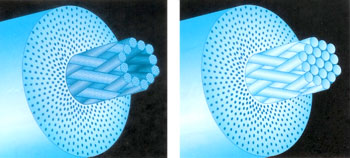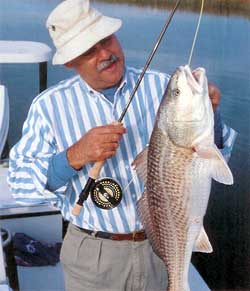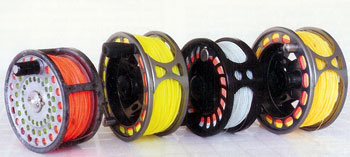Line of Sight
IT’S BEEN SAID THAT a fly fisherman can buy his way around the world to find any game fish, but he always has to cover the last 50 feet on his own — meaning the cast. This salty aphorism is never more true than when sight-fishing in the flats, where an angler’s skill and tackle must work in perfect unison.
As big and plentiful as deep-water fish can be, saltwater fly fishing is really at its most exciting and demanding on the flats. Here you are hunting a fellow predator that has braved its way into uncomfortably shallow water to feed. He is constantly looking for food, searching left and right and making for a difficult, moving target. As if this is not hard enough, the skinny water makes these fish forever nervous. Whether we’re talking bonefish in the Bahamas, big Yucatan permit, giant Florida tarpon, Nantucket flats stripers, or backwater redfish, shallow-water sight-casting demands the ultimate fly-fishing skill. Clean presentation is the key to every catch; therefore, no single bit of tackle is more important than the proper fly line.
In most sight-casting situations, your average shot will probably be from 15 to 65 feet. Redfish in off-color water dictate shorter distances, while finicky permit on crystalline flats represent the longer side. The basic shape of a good fly line for sight-casting is usually similar for all these species. But the varying temperatures and salinities you will encounter from species to species call for different fly lines if you want to maximize your casting efforts.
Flats Fly-Line Design
Ideally, you want a weight-forward fly line with a head short enough that, within the first couple of false casts, most of the weight is out and the rod loads quickly. But the head should be long enough that you do not have to shoot too much line and lose accuracy. For example, with a 30-foot head, you’d probably have to shoot too much line to reach 60 feet and still be accurate. (The head of a fly line is comprise the front taper, belly, and rear taper.)
Since most sight-casts fall around 35 to 60 feet, a head of roughly 40 feet with a 10-foot leader makes a good general-purpose combination. If you are false-casting to a fish 60 feet away, and you have a combined head-and-leader length of 50 feet, you’ll have to shoot only 10 more feet to reach the fish. When you have to shoot a lot of line, accuracy suffers. If, say, you are making a presentation 50 feet away, you want to false-cast 45 feet and, on the last cast, shoot only five feet. You can be very accurate this way.
Why not false-cast the whole 50 feet to a fish that is 50 feet away? Because fish in shallow water do not like anything flying over their heads. False-casting directly over a fish will spook it. Get used to shooting just a few feet at the last moment.
Nowadays, most fly lines sold for sight-casting have a head length of around 40 feet. Lately, there have been some sight-casting tapers with heads as short as 30 feet, mainly for reds in poor visibility or muddy water. If you fish in stained water for reds, snook, or baby tarpon, then the shorter heads may work very well for you.
The Temperature Factor
When line manufacturers first tried to create fly lines specifically for the tropics, the first problems they encountered were extreme heat and humidity. Throw in the harmful admix of bug repellent and sunscreen, and those old lines took a beating. They were super soft, hung on the rod like wet linguine, and stuck to the guides. Excessive line dressing did help, but not much.

Braided multifilament (top left) and monofilament (top right) cores yield different performances on the flats. Multifilament cores are hollow, float higher, and remain supple in cool weather. But they wilt in the tropics. Braided monofilaments produce a stiffer line that tolerates heat better but will be too stiff in cooler weather. Single monofilament cores (not shown) are often used with clear-tip sinking or intermediate lines and and also have sight-casting applications. Illustrations Courtesy of Scientific Anglers
To overcome the heat, you need a stiff line that resists becoming overly supple throughout the day. To that end, manufacturers now offer tropical lines with harder, tougher coatings that will shoot well through the guides. But the factor that makes these lines truly different is the core. Instead of the soft-braided, multifilament nylon core of most fly lines, today’s hot-weather lines have either a fat, single-monofilament core or a braided monofilament core of many strands. Both types make for a stiff fly line with good shooting capabilities.
However, the price of a stiff line — and the great performance that comes with it — is high memory coming off a reel. These tropical lines need a good stretching at the beginning of the day, and often again around midday if you are fishing for tropical species in cooler weather. For this reason, I prefer braided-monofilament cores. They stretch easier and straighten very well.
However, what happens if you are redfishing with these same tropical lines during the winter in Texas, Louisiana, or South Carolina, or for Nantucket flats stripers early or late in the season? Or even on a cold day in South Florida? The stiffness factor becomes a liability, and the line will come out of the reel looking like a tempered steel spring. Here you need to go back to a fly line with the same 40-foot head, but now but with a softer braided-nylon core.
The Salinity Factor
All these fish that we commonly sight-cast to don’t live in waters of the same salinity. While bonefish and permit need maximum salinity, many tarpon, redfish, and snook cruise backwaters with very low salt content. I’ve taken plenty of snook, small tarpon, and even redfish mixed with black bass in pure fresh water.
But this presents a problem for many tropical fly lines. Since buoyancy is a function of water density, and saltwater is denser than fresh, fly lines made to fish the flats in pure salt water do not need as much flotation, which is created by small air pockets trapped in the line coating. The minimal air keeps the diameter of these lines as small as possible so you have a line that floats well enough and cuts through the wind like magic.
Take one of these lines from the bonefish world to fish for redfish in the brackish backwaters of northern Florida, however, and you’ll have a line with too much memory that takes constant stretching, and that will not float well. It just does not belong there. In this situation you need a softer line with the more common braided-nylon core to minimize memory and enhance flotation. A line with plenty of air in the coating will float higher in sweet water. In fact, bass-bug tapers often work as well as anything.
There are some rigging limitations when you choose a tropical line. Because the braided monofilament and monocores used to make the line stiff are not hollow — unlike all-braided-nylon-core fly lines — you cannot use a needle knot or any other connection in which you need to insert the butt of the leader inside the core. You typically rig these lines with a plain six- to eight-turn nail knot or a loop-to-loop connection. But this is a minor detail.
So, lines made for the salty, warm temperatures, with their smaller diameters and tough finishes, are capable of casting a loop into a strong wind and turning a fly over at the end of the cast. They are great performers. On the other hand, in its element, the softer, fatter, braided-nylon core lines are more subtle, perhaps even more elegant, while still shooting line pretty well. And their slower loop provides better accuracy. Presentation is a bit more delicate, and picking a lot of line off the water to make another cast is easier, producing less noise than the high-performance warm-water lines.
I do know many anglers who manage to fish both the cold and hot flats with one type of fly line. Me? I switch as conditions dictate. Let’s face it, a fly line costs about what you’d tip a guide these days. And the life of a fly line, if properly maintained, is many years. As far as I’m concerned, fly lines are relatively cheap. Accurately casting in the wind to a spooky fish in the flats is hard enough, so I’ll take all the help I can get. I politely suggest you do the same.














